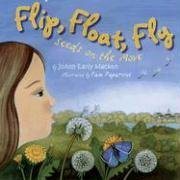Flip, Float, Fly
I’m revisiting this book (one of my favorites) while I’m working this week on a Quality Review Panel. You can learn more about this organization at Creating Quality. This book was featured on The Reading Rainbow App Trailer.
Flip, Float, Fly: Seeds on the Move
Illustrated by Pam Paparone
Holiday House, 2008
ISBN# 0-8234-2043-4
Nonfiction picture book
Vivid illustrations add depth to this book that traces the wide variety of ways seeds move about. In simple, sparkling language, the movements by seeds as they spread are shown and explained as they complete their life cycle. Back matter includes more seed and plant facts and a final page adds notes about why seeds must move.
Tumbleweed plants grow as round as globes. In autumn their stems snap off. On the flat, open prairie, they ROLL, ROLL, ROLL, sprinking their seeds as they tumble.
Activity 1
Use this book to start a seed experiment. Choose one variable to test (amount of water, light and dark, planting depth, or seed type). Give each student two small paper cups and fill with soil. One is the control and the other is the variable. Use 2-3 seeds for each cup. I recommend bean seeds, because the plant grows well and relatively fast.
Set up the experiment and plant the control seeds normally. Then set up the second cup according to your choice of variable. From now on, keep everything other than the variable equal. Fill out the scientific method form as you plan and perform the experiment and watch the seeds grow.
Activity 2
Use a metric ruler and measure the growth of the two sets of bean plants in millimeters. Record the results each day. Use the results to make a line graph of both and make your conclusions.
National Science Standard: understanding about scientific inquiry, life cycles of organisms
See a review of Flip, Float, Fly.








Shirley Smith Duke's Blog




